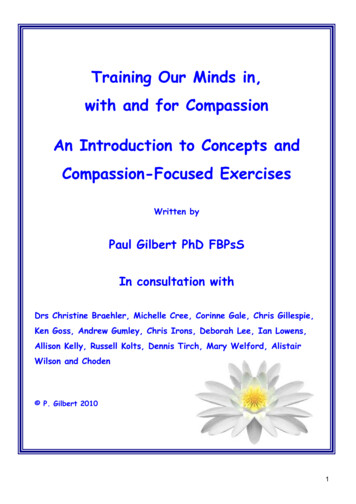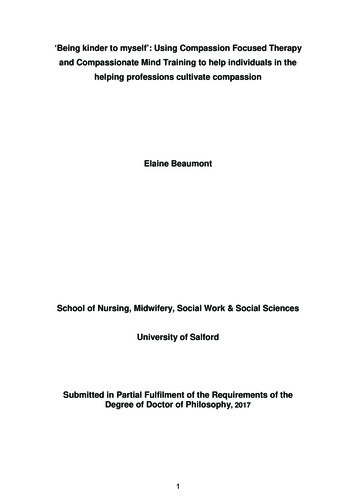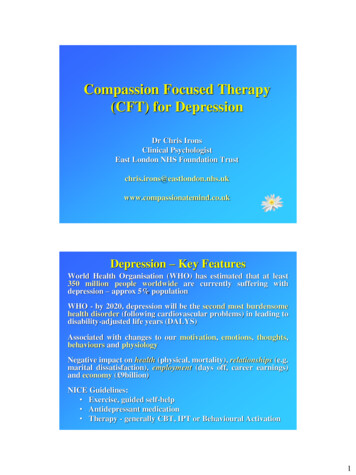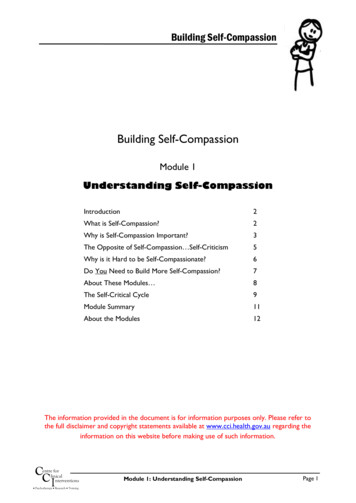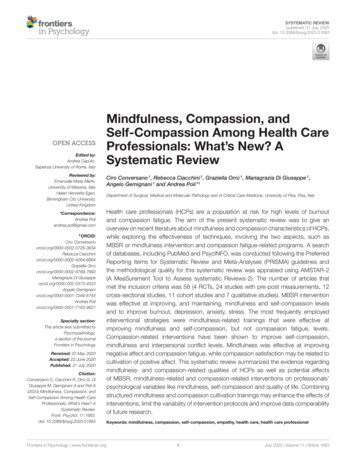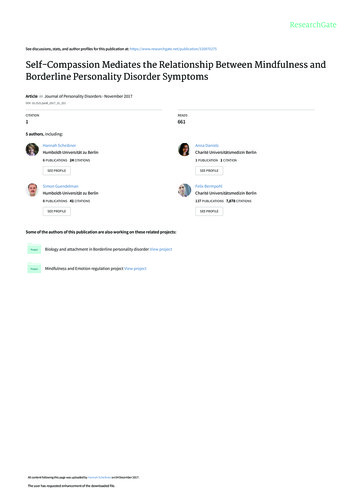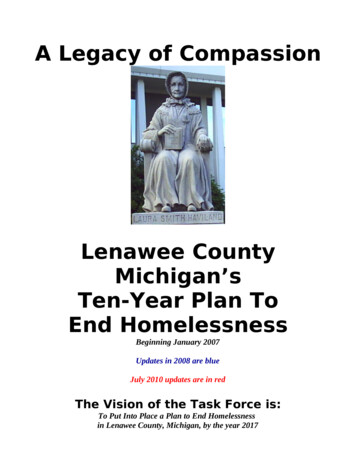
Transcription
A Legacy of CompassionLenawee CountyMichigan’sTen-Year Plan ToEnd HomelessnessBeginning January 2007Updates in 2008 are blueJuly 2010 updates are in redThe Vision of the Task Force is:To Put Into Place a Plan to End Homelessnessin Lenawee County, Michigan, by the year 2017
The purpose of this plan is to put into place a mechanism to provide homeless persons with thenecessary options that will lead to permanent housing. We understand that homelessness is a complexissue with no one simple solution. It is commonly accepted that while the existing homeless systemworks well for some persons, it has not been effective enough at permanently ending homelessness.We can no longer afford to cycle people through emergency housing and then back to the streets, onlyto endlessly repeat this pattern. However, Lenawee County’s homeless system as it exists today doesnot effectively address the path to permanently house everyone who desires housing.Members of the Task Force To End Homelessness in LenaweeCountyCatholic CharitiesCommunity Action AgencyConcerned CitizensDepartment of Human ServicesDo’ Chas II CounselingHabitat for Humanity of Lenawee CountyHomeless Education Programs of Lenawee CountyHOPE Community CenterFamily Counseling & Children’s Services of Lenawee CountyHomeless and Formerly Homeless PersonsGoodwill Industries of Southeastern Michigan, Inc.Government officials K. Z. Bolton, Lenawee County Commissioner Gary McDowell, Mayor of Adrian Jae Guetschow, Village President of BlissfieldLenawee Community Mental Health AuthorityLenawee Emergency and Affordable Housing CorporationThe Salvation ArmySouth Central Michigan Works!United States Department of AgricultureVeterans’ Affairs AdministrationThe Lead Agency: The Lenawee County Continuum of Care (CoC) serves as Chair of the Partners forthe development of a Ten-Year Plan to End Homelessness in Lenawee County and chairs the AdvisoryBoard to End Homelessness in Lenawee County.Lead Contacts: Jae Guetschow, Department of Human Services, Village President of Blissfield;Khristine Henson-Jones, Lenawee Emergency and Affordable Housing Corporation; Sharon Hudson,Family Counseling & Children’s Services of Lenawee County.Fiduciary Agency: Family Counseling and Children’s Services of Lenawee CountyAbout Lenawee County, MichiganA Legacy of CompassionLenawee County has a long history of compassion for the less fortunate.2
Laura Smith Haviland was a tiny frontier woman who in the early 1830’s helped to organize thefirst anti-slavery society in Michigan. Later she and husband Charles established the first stationon the “Underground Railroad” in Michigan, helping escaped slaves slip through to Canada andfreedom. After Charles’ death in 1845, Laura intensified her involvement in the UndergroundRailroad. In 1846-47 she cleverly foiled the efforts of men from the south to return a family ofescaped slaves to bondage. In their rage, the men placed a price of 3,000 on the head of this tinywoman, dead or alive. She defied the offer, making repeated trips to Cincinnati, Ohio, to help escaped slaves.She even slipped into Kentucky, to assist slaves and to encourage an imprisoned abolitionist. She personallyescorted some escapees all the way to Canada. A life-sized statue sits in front of the Adrian City Hall. (Lee M.Haines, 1977, Laura Smith Haviland: A Woman’s Life Work)The Lenawee County Asylum for the Poor: “On March 25, 1836, the board ofsupervisors purchased land to be used for the purpose of establishing a poor-housein said County of Lenawee. The increase in the population in this locality, theincoming of new families, the infirmities of age and the unfortunate condition ofsome persons who had become a charge upon the public, led to the establishment ofan institution within the county, to be maintained at public expense, called theInfirmary, as a home for aged, decrepit and indigent persons. Inmates who are able to work are employed onthe farm, or in caring for stock and “choring” on the premises. Good, wholesome and substantial food isprovided in abundance, as is also comfortable and seasonable clothing and volunteer ministers from variouschurches in the county supply the spiritual needs.” (Source: www.lenaweehistory.com, 8.2.2006)While attending Hillsdale College 1865-1869, Lenawee County native Will Carleton visited thelocal poor farm. He sat in the house to talk with an old lady as to how she came to be in thehome. She told him of her troubles and these became the basis of the poem “Over the Hill tothe Poor-House.” In 1904, Carleton wrote he had received many letters from superintendents ofpoor houses, after Harper’s Weekly published the poem there was a “decrease in the number ofinmates, occasioned by the withdrawal of old people, whose children were ashamed.” In 1964,a Detroit Free Press article stated that: “In awakening society to the inhumanities faced by countless olderpeople, it helped create public demand for a social security program.” (Source: Pamphlets provided by the WillCarleton Poorhouse.)The Salvation Army began as the Christian Mission in London, England,in 1865. Amazingly, thirty-one years later it had touched the hearts ofLenawee County. The Salvation Army began its ministry in Adrian andto Lenawee County on January 16, 1896 under the leadership of CaptainThomas Bullock and Lieutenant John McGee at the Maumee StreetMission. Over the years, the Corps expanded programs and operated outof several locations. It opened its doors at the present Church Street location in 1929. Currently the socialministry of The Salvation army extends emergency housing, clothing, community meals, and food to thehomeless population, as well as spiritual guidance through the church. (Pamphlet)The American Red Cross came to Lenawee County in 1917 as part of a mandate by Congressto provide relief to disaster victims and services to members of the U.S. armed forces.(Pamphlet)In the early 1970’s, Call Someone Concerned Inc., received countlessdesperate cries forhelp from women in violent relationships. In 1978, a program directorwas hired todevelop and provide services specific to victims of domestic violence.One of the mostpressing needs was a safe, confidential shelter. Volunteer homes wereestablishedthroughout the county. Additional space was rented to shelter one ortwo families needing intensive care. In 1983, a grant was presented by the City of Adrian to purchase andrenovate a facility where more families could be sheltered and all domestic violence services could beconsolidated into one place. In 1984, the facility officially became known as the Catherine Cobb Domestic3
Violence Shelter. In 1990, the program became part of Family Counseling and Children’s Services of LenaweeCounty. In 1992, services to homeless women were added. In March 2003, renovations were completed thatdoubled the number of clients that could be housed and served. (Pamphlet)In the late 1980’s, Lenawee County community leaders realized there were no programstargeting citizens in housing crisis. No one knew how many people were impacted by thislack of service, but the sense was that the numbers were growing with each year. As aresult, the Basic Needs Task force, a branch of the Human Services Council, helped tocreate a Housing Task Force. In 1990, out of this need and in collaboration with the AdrianDominican Sisters, Lenawee Emergency and Affordable Housing Corporation (LEAHC)was founded and later incorporated in 1991. LEAHC is a Michigan not-for-profitcorporation providing emergency shelter, transitional housing, permanent housing and direct client assistance inthe form of financial aid for past due and first months rent. (Pamphlet)Share the WarmthIn January 2004, a group of caring individuals from the various churches in Lenawee County were veryconcerned about the increase in homelessness in the County. The group collaborated to find an answer to thisgrowing problem. Volunteers were recruited from these interested churches and various church halls were usedto shelter the homeless at night during the winter months. There was such a positive response to the initialproject that this ministry continues to provide services each winter. For the winter 2009, this group offeredovernight accommodations from December through the end of April and it was hosted by The Salvation Army.Campaign To End HomelessnessIn January 2006, the State of Michigan began to focus on the Campaign To End Homelessness. The LenaweeCommunity Collaborative initiated the effort to develop Lenawee County’s Ten-Year Plan to EndHomelessness. The Lenawee County Continuum of Care (CoC) created the Memorandum of Understanding.As a result, the newly formed Advisory Board to End Homelessness in Lenawee County is in the process ofdeveloping the vision of ending homelessness in the next ten years in this County and carrying that visionforward.Geographic AreaLenawee County Michigan is in Southeastern Michigan. It is made up of 761 square miles of residential andfarmland and is now considered to be “micropolitan.” It includes: Cities of: Adrian, Hudson, Morenci, and Tecumseh.Villages of: Addison, Blissfield, Britton, Cement City (partially), Clayton, Clinton, Deerfield, Onstedand Manitou Beach-Devils Lake, CDPTownships of: Adrian Township, Blissfield Township, Cambridge Township, Clinton Township,Deerfield Township, Dover Township, Fairfield Township, Franklin Township, Franklin Township,Hudson Township, Macon Township, Madison Charter Township, Medina Township, Ogden Township,Palmyra Township, Raisin Township, Ridgeway Township, Riga Township, Rollin Township, RomeTownship, Seneca Township, Tecumseh Township and Woodstock Township.DemographicsThe following data is from Wikipedia and was last modified on July 8, 2006.“As of 2003, the estimated population was 101,786. According to the 2000 U.S. Census there were 98,890people, 35,930 households, and 26,049 families residing in the county.The racial makeup of the county waso 92.51% Whiteo 2.12% Black or African Americano 0.41% Native American4
ooooo0.46% Asian0.01% Pacific Islander3.01% from other races1.49% from two or more races6.96% of the population was Hispanic or Latino of any race.There were 35,930 households out of which:o 34.20% had children under the age of 18 living with themo 58.70% were married couples living togethero 10% had a female householder with no husband present and 27.50% were non-familieso 22.90% of all households were made up of individualso 9.7% had someone living alone who was 65 years of age or older.The average household size was 2.61 and the average family size was 3.07.”The median income for a household in the county was:o 45,739o The median income for a family was 53,661o Males had a median income of 38,458 versus 25,510 for females.o The per capita income for the county was 20,186Approximately 4.40% of families and 6.70% of the population were below the poverty lineo 7.10% of those under age 18o 9.20% of those aged 65 or over.According to a September 4, 2006, ABC News report, the gap between the highest and lowest incomeAmericans is widening. The top one fifth of the American population have half of all income. The Net Worth of30 percent of the population is less than 10,000. In 2000, the richest one percent of the people had more moneyafter taxes than the bottom 40%. In 2000, the top 1% earned an average of 862,700 after taxes, a 201 percentincrease since 1979. This compares to the bottom 40 percent who earned an average of 18,695 in 1979, whichincreased by 13 percent to 21,118 in 2000.According to statistics for Lenawee County, the jobless rate this year hit a high of 8 percent in February and 8.1percent in March before improving to 6.3 percent in May and rising in June to 6.8 percent, the latest figureavailable. The Lenawee County jobless rate was 6.5 percent in June a year ago and an average 6.9 percent for allof 2005. According to the statistics, the estimated number of unemployed workers in the county seeking jobsdeclined from 4,038 in March to 3,431 in June. (Daily Telegram, 8.25.2006)Unemployment in Lenawee County remains close to the statewide rate, which rose from 6.3 percent in June to 7percent in July, according to the Michigan Department of Labor and Economic Growth. The rate was slightlyabove the 6.7 percent reported for July 2005. Michigan’s rate remained above the national unemployment rate of4.8 percent. (Daily Telegram, 8.25.2006)Major Employers PromedicaWacker GEState of MichiganCounty of LenaweeLenawee County School DistrictsMerillat Industries – closed manufacturing in 09Siena Heights UniversityL & W EngineeringDelphiVenchurs/NuestroLenawee Stamping CorporationBrazeway – closed manufacturing in 09Blissfield ManufacturingInergy Automotive Systems5
First Federal BankMeijerUnited Bank and TrustWal-MartJackson Community College (Lenawee Site)Adrian CollegeGus Harrison Correctional FacilitiesA host of agriculture related entitiesHousingThe Environmental Scan of Lenawee County, December 2003 completed by the Lenawee United Way andVolunteer Center:There are 39,769 housing units in 2000 of which: 35,930 were occupied, of these 1,911 were for seasonal recreation or occasional use 3,839 were unoccupied 131 lacked complete kitchen facilities 218 lacked complete plumbing facilities 1,688 lacked telephones.The median rent in Lenawee County increased 64% from 1990 to 2000, while the median owner-occupied homevalue increased 103%. The median owner-occupied home value in 2000 was 109,500. In 2002, 1,051 homeswere sold in Lenawee County with an average price of 135,556.The “fair market” rent in Lenawee County is 647 for a two-bedroom unit. Fair market rent is the amount usedby the U.S. Department of Housing and Urban Development to determine eligibility for the Federal HousingAssistance Payments Program. The figure is among the highest in the state. (At minimum wage of 6.95 an houra person has to work approximately 93 hours a month just to pay the rent). As of July 2003, there were 2,145rental units in apartment complexes in Lenawee County: 841 one-bedroom units, 876 two-bedroom units, 206three-bedroom units, 12 four-bedroom units and 210 studios. Seven complexes are targeted towards seniors,while another five complexes have more than 50% senior occupancy. Government-sponsored affordable housingprograms assist about half of the complexes; these have an average occupancy of 90%. The average cost of atwo-bedroom apartment in Lenawee County is 750 per month. Currently, the waiting list for subsidized housingis approximately 2 years in Lenawee County.6
Defining the NeedDefinitions of HomelessnessThe Advisory Board To End Homelessness in Lenawee County Defines Homelessness as: staying in aplace not meant for permanent human habitation, in an emergency shelter, in transitional housing ortemporarily doubled up with others due to lack of economic means or lack of affordable housing.HUD definitions of Homelessness include: “Chronically homeless person: an unaccompanied homeless individual with a disabling conditionwho has either been continuously homeless for a year or more or has had at least four episodes ofhomelessness in the past three years. A disabling condition is defined as “a diagnosablesubstance use disorder, serious mental illness, developmental disability, or chronic physicalillness or disability, including the co-occurrence of two or more of these conditions.” In definingthe chronically homeless, the term “homeless” means “a person sleeping in a place not meant forhuman habitation (e.g., living on the streets) or in an emergency homeless shelter. Homeless Person means a person sleeping in a place not meant for human habitation or in anemergency shelter.”Some of the Cost of HomelessnessThough the total cost is incalculable, the following are some of the costs to area agencies servinghomeless persons for the 2007 calendar year:Catherine Cobb Domestic Violence Shelter: 457,142Lenawee Emergency and Affordable Housing Corporation (LEAHC): 272,557The Salvation Army: 254,000The Daily Bread: 160,000Homeless Education Program: 148,000Promise Project: 7,000Share the Warmth: 1,100Total: 1,299,799The Homeless of Lenawee County,MichiganThe exact number of homeless in Lenawee County, Michigan, has been difficult to determine. However,there are three Point-In-Time counts data for review.20057
On January 25, 2005, 75 individuals were counted as homeless; of those 24 identified themselves asCouch Homeless.HUD HomelessHUD Homeless Individuals 51 38 females 13 malesAverage age of individual: 31 Youngest adult was 17 Oldest was 61Length of homelessness: 15 months Shortest period was 1 day Longest 10 yearsNumber of times homeless: 2.33Homeless Children: An average of 2 children with each adultCurrent living environment: Car, Woods, MotelReasons given for being homeless: 11 were victims of domestic violence, 5 were chronic substanceabusers, and 7 were youthCouch HomelessCouch Homeless 2416 females8 malesAverage age of individual: 29Youngest adult age was 17Oldest was 54Length of homelessness: 9 monthsShortest period was 1 monthLongest was 6 yearsNumber of homeless episodes: 2.24Number of children: An average of 2 children with each adultWhere do they stay? Family and FriendsReasons for homelessness: 11 were youth, 2 were victims of domestic violence, and 2 were dischargedfrom jailSelf- identified reasons for homelessness includedDomestic ViolenceLack of Jobs/UnemploymentSeparated from spouseLack of IncomeIn DebtParents IncarceratedReleased from Maurice SpearDisabled/Chronic IllnessHad to move (evicted, kicked out)Business closingFight with FamilySexual Abuse2007On January 25, 2007, the Lenawee County Continuum of Care conducted another Point In Time Count ofthe homeless and defined Homelessness to include couch homeless. Total 239Total Lenawee County Homeless 239 Adults 179 Children 19 Unknown 41Clients within a Family 146 Adults 100 Children 5 Unknown 41Clients who are Single 938
Adults 79Children (Youth) 14Total HUD Homeless 93. Homeless Subpopulations as defined by HUD defined.ShelteredUnshelteredChronically Homeless191Severely Mentally Ill10**Chronic Substance Abuse20**Veterans3**Persons with HIV/AIDS0**Victims of Domestic Violence18**Unaccompanied Youth (Under 18)27**** HUD does not want unsheltered numbers for subpopulations, exception is Chronically Homeless.2009On January 28, 2009, the Lenawee County Continuum of Care conducted another Point In Time Count ofthe homeless and defined Homelessness to include couch homeless. Total 229Note: On the day of the Point In Time Count there was very limited transportation available (bus lines were shut-down) becauseof winter weather, which significantly impacted an accurate count.Total Lenawee County Homeless 229 Adults 116 Children 113Clients within a Family 161 Adults 54 Children 107Clients who are Single 68 Adults 62 Children (Youth) 6Total HUD Homeless 114. Homeless Subpopulations as defined by HUD.ShelteredUnshelteredChronically Homeless11**Severely Mentally Ill14**Chronic Substance Abuse13**Veterans3**Persons with HIV/AIDS0**Victims of Domestic Violence21**Unaccompanied Youth (Under 18)8**9
Resources in Lenawee County, MichiganWhile a majority of the area’s agencies are represented, this section is not to be construed as the onlyresources available. This section is an evolving product as new resources are identified.Adrian REA Literacy Center – Provides quality literacy programs in a welcoming environment for adults.Located at Adrian Dominican Sisters, 1257 E. Siena Heights Drive, Adrian. Phone: 517-266-4260.The American Red Cross*: Services for Natural Disasters, there are national guidelines for servicesprovided. For Personal Disasters, for personal disasters they can provide 3-night stay in a motel.Provides communications and welfare services to the military. Distribution of personal hygie
two families needing intensive care. In 1983, a grant was presented by the City of Adrian to purchase and renovate a facility where more families could be sheltered and all domestic violence services could be consolidated into one place. In 1984, the facility


